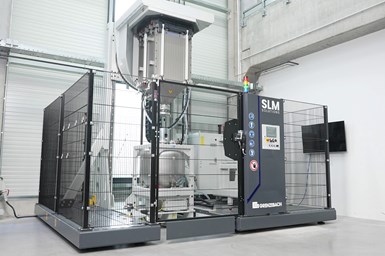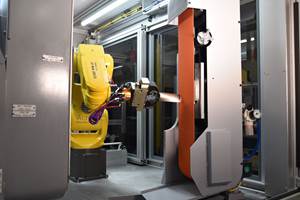Grenzebach Develops Automated Depowdering System for SLM Solutions
The DPS NXG enables automated depowdering of 3D components up to 2.3 tons.
Share
Read Next
SLM Solutions has relied on Grenzebach’s expertise in developing a depowdering solution for its NXG XII 600 printer. In less than 12 months, automation specialist Grenzebach has developed, designed and manufactured a market-ready depowdering solution for SLM Solutions.
The project started in March 2021 with the solution enabling 3D printing operators to mass produce metal components on an industrial scale. Sebastian Feist, product manager factory integration ande periphery at SLM Solutions, is pleased with about the project's success. “Multiple production versions have been built and delivered to our NXG XII 600 customers in various countries,” Feist says. “More than 15 systems have been ordered.”
The depowdering system provides a effective extension of the NXG XII 600 from SLM Solutions. A lot of loose powder clinging to the component must be removed in powder-based 3D metal printing after the build job. This is often still done manually. SLM Solutions was looking for a partner for its NXG XII 600 3D printer to develop an automated depowdering solution for its customers with huge components (up to 2.3 tons) that would minimize manual intervention but remain cost-efficient. Out of 17 potential suppliers, SLM Solutions finally chose the Grenzebach Group. “We chose Grenzebach due to their many years of experience in development, automation and handling of heavy components,” Feist adds.
SLM Solutions and Grenzebach developed a first concept draft together. After evaluating the concept and selecting the configuration, Grenzebach started with engineering and building the first prototype. In February 2022, Grenzebach sent the prototype to Lübeck, the German headquarters of SLM Solutions, and commissioned it. The entire project, from the inquiry to the delivery, took less than 12 months.
Oliver Elbert, head of additive manufacturing at Grenzebach, considers open communication to be a main factor for the project’s success. “We at Grenzebach see ourselves as journey partners to our customers and other partners, meaning that we always stay in close contact by holding regular meetings and discussions to receive feedback on the equipment supplied and future market requirements, so that we can promptly factor this into our developments,” Elbert adds.
The DPS NXG depowdering solution for large metal components can process cylinders weighing up to 2.3 tons. Due to the inert gas environment, it depowders over a ton of powder with gravimetric flow and enables the highest possible operator safety. Manual intervention is no longer required. The powder can also be fully reused. The depowdering process is carried out in two stages to achieve the best possible quality. The station also includes an unpacking function for the building job and enables operators to prepare the build cylinder for the next job.
The depowdering solution is highly automated and assists plant operators throughout the entire process of depowdering and unpacking parts. “The depowdering solution was developed with a focus on safety and achieving the best depowdering results,” Elbert explans. The system navigates through each process step. It starts with a fully printed SLM build cylinder, continues with the transfer of the inerted powder from the cylinder to the module tank, to vibration-assisted cleaning, unpacking and packing of the cleaned component, and ends with the cylinder ready for the following SLM process.
Both partners say the partnership has been extremely rewarding. “We will continue our cooperation with Grenzebach,” Feist says. “We are already developing a joint, new depowdering solution for our NXG XII 600E printer. We are both striving to develop better technologies to meet the growing needs of our customers in all major industries and pave the way to series production.”
- In another partnership, SLM Solutions is working with Assembrix to ensure secure remote printing. Following the integration of Assembrix VMS software into SLM Solutions’ machines, both companies are now working to ensure the enhanced safety and full protection of customers' intellectual property, which is made possible through the utilization of blockchain and encryption technologies.
- Learn more about SLM Solutions’ NXG XII 600E which offers an extended build envelope. The NXG XII 600E is an advanced productive system featuring an end-to-end production workflow, including external cooldown unpacking to maximize machine uptime, enabling job-to-job turnover under one hour.
Related Content
AM 101: What Is Hot Isostatic Pressing (HIP)? (Includes Video)
Hot isostatic pressing has long been used for metal castings, but is now being applied as a valuable method for closing porosity in metal 3D printed parts.
Read MoreNew Zeda Additive Manufacturing Factory in Ohio Will Serve Medical, Military and Aerospace Production
Site providing laser powder bed fusion as well as machining and other postprocessing will open in late 2023, and will employ over 100. Chief technology officer Greg Morris sees economic and personnel advantages of serving different markets from a single AM facility.
Read MoreAircraft Engine MRO: How Additive Manufacturing Plus Robotic Finishing Will Expand Capacity for Blade Repair
AM offers the chance to bring fast, automated processing to individualized, part-by-part restoration of turbomachinery. A cell developed by Acme Manufacturing and Optomec is able to automatically repair 85,000 unique aircraft engine blades per year.
Read MoreHow Does Heat Treating Affect Machining Considerations for a Metal 3D Printed Part?
This picture of part distortion in additive manufacturing illustrates the kind of effects that part design or machining stock allowances need to anticipate.
Read MoreRead Next
4 Ways the Education and Training Challenge Is Different for Additive Manufacturing
The advance of additive manufacturing means we need more professionals educated in AM technology.
Read More3D Printing Brings Sustainability, Accessibility to Glass Manufacturing
Australian startup Maple Glass Printing has developed a process for extruding glass into artwork, lab implements and architectural elements. Along the way, the company has also found more efficient ways of recycling this material.
Read MoreAt General Atomics, Do Unmanned Aerial Systems Reveal the Future of Aircraft Manufacturing?
The maker of the Predator and SkyGuardian remote aircraft can implement additive manufacturing more rapidly and widely than the makers of other types of planes. The role of 3D printing in current and future UAS components hints at how far AM can go to save cost and time in aircraft production and design.
Read More












.png;maxWidth=300;quality=90)











